With the London 2012 Olympics around the corner, there are sure to be reports or rumors of performance-enhancing drug use among some athletes. It turns out that using manufactured chemicals to give yourself an edge is frowned upon in the athletic community. However, as a SAS user you should avail
Author
If you've heard anything from SAS in recent months, then you've heard about high-performance analytics and the new SAS Visual Analytics offering. SAS has taken the high-performance analytics message around the world in a series of recent "road shows". From the start, this project has enjoyed a different development process
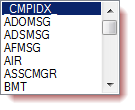
A SAS Professionals attendee and Twitter follower named Marco asks for help: ..struggling to find a method with custom tasks in EG to be able to list the datasets in a library, can you help please? Sure, no problem. This is easy-peasy-lemon-squeezy. First, make sure that you have a reference

"Welcome to the English summer." "In the US you have climate. In England we have Weather." These are just two of the familiar phrases I heard yesterday during the SAS Professionals Convention held at SAS UK in Marlow. The weather changed from sun to dark clouds to rain and even
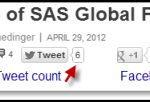
Update 24Nov2015: The methods in this post no longer work for Twitter, as Twitter has discontinued support for its "share count" API that was used within the Twitter share buttons. But the Facebook method still works, and I've described a method for counting LinkedIn shares on another post. As of

A colleague was recently working with a web service that supplies some datetime values using the Microsoft Windows internal representation. He called the web service to retrieve those values (along with other data) from SAS, and he needed convert these values to SAS date-time values. The Microsoft definition for a
Last Friday morning I took a meeting with SAS CEO Jim Goodnight. Despite the hassle, I was happy to rearrange my busy schedule to squeeze him in. Ha! Just a little joke there about my inflated sense of importance! Actually, the meeting was part of a regular series called "Conversations
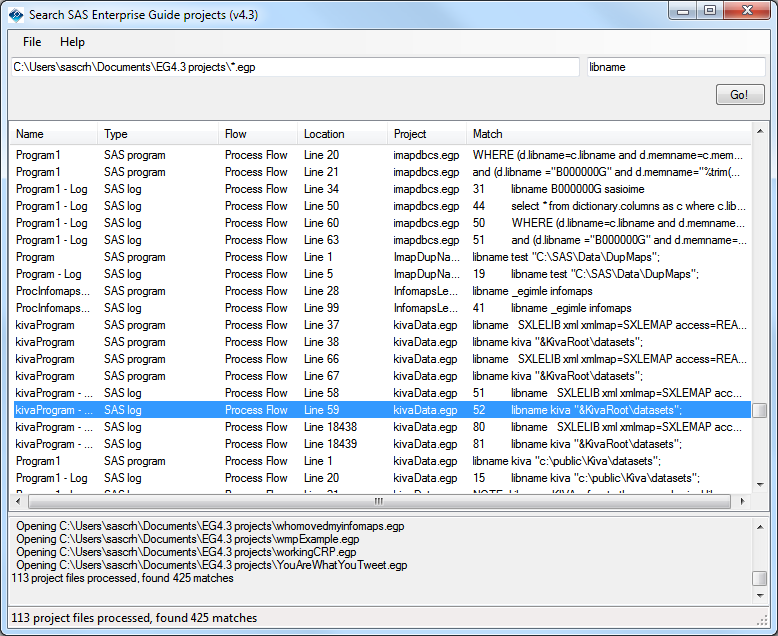
If you are like many SAS Enterprise Guide users, you've amassed a large collection of project files (EGP files) that contain important content: programs, logs, notes, results, and more. However, to most tools and processes, the EGP file is opaque. That is, you can't see what's inside of it unless

It's been two years since my first trip to SAS UK for the SAS Professionals Convention. That was also my first trip to the UK, ever. I was pretty naive back then and didn't know what to expect from this strange land and its people. I was shown tremendous hospitality
Back in 2009, I announced that SAS was developing a version of its business analytics platform for use on the Nintendo Wii. I think I gave our legal department a heart attack with this news, until they realized that I had posted it on April 1. At SAS Global Forum

On the SAS-L mailing list, a participant posed this question (paraphrased): How can I tell which date format my Windows session is using: European format (with day first) versus USA format (with month first)? I'm reading in output from a Windows file listing, and need to know how to interpret
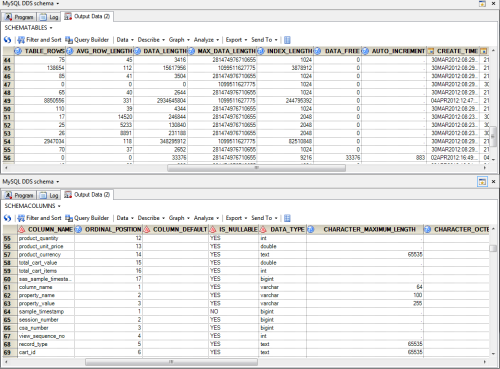
It's Friday, and on SAS Voices they are posting fun stuff about dogs who work at SAS. I'm posting about PROC SQL and MySQL. You tell me - which of us knows how to ring in the weekend with style? I've been working with MySQL data sources lately, and SAS/ACCESS
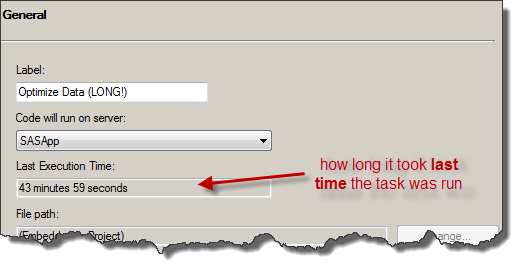
SAS users, by definition, do not embrace the mysterious. That's one of the main reasons that they use SAS: to demystify some data or process. And so, when you (as a SAS user) have gone to the trouble of designing a process flow in SAS Enterprise Guide, you like to

In a previous post I showed how you can use Windows PowerShell (with the SAS Local Data Provider) to create a SAS data set viewer. This approach doesn't require that you have SAS installed, and allows you to read or export the records within a SAS data set file. In

Many SAS customers are quickly adopting 64-bit versions of Microsoft Windows, and they are pleased-as-punch when they find a 64-bit version of SAS to run on it. They waste no time in deploying the new version, only to find that a few things don't work quite the same as they

Question: What do John Travolta, Gina Davis, and I all have in common? (I mean, besides the obvious fact that we are all awesome dancers.) Answer: We have all had makeup applied by artist Roxie Stice. I was the host for two SAS Tech Talks, which were broadcast via Livestream
When I first joined SAS in 1993, we were gliding into the golden age of 32-bit computing on the PC. Microsoft offered a new extension to Microsoft Windows 3.1 called Win32s, and it allowed 32-bit applications to run on the Windows operating system. SAS Version 6.10 for Windows was one
For me, this will be a SAS Global Forum of many "firsts". My first Closing Session. My first time attending as a staffer outside of SAS R&D (well, except for the chilly SUGI 21 in Chicago). And my first chance to host the SAS Tech Talk sessions, which will be
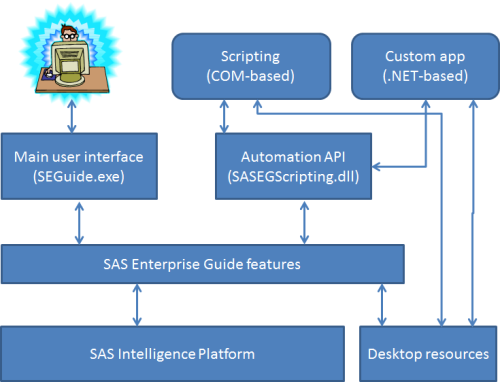
Have you ever selected File->Schedule Project or Schedule->Process Flow in SAS Enterprise Guide? Are you curious about what magic these actions will trigger? Here's what happens: SAS Enterprise Guide creates a VBScript program that contains the instructions to start SAS Enterprise Guide, load your project, run your project or flow,
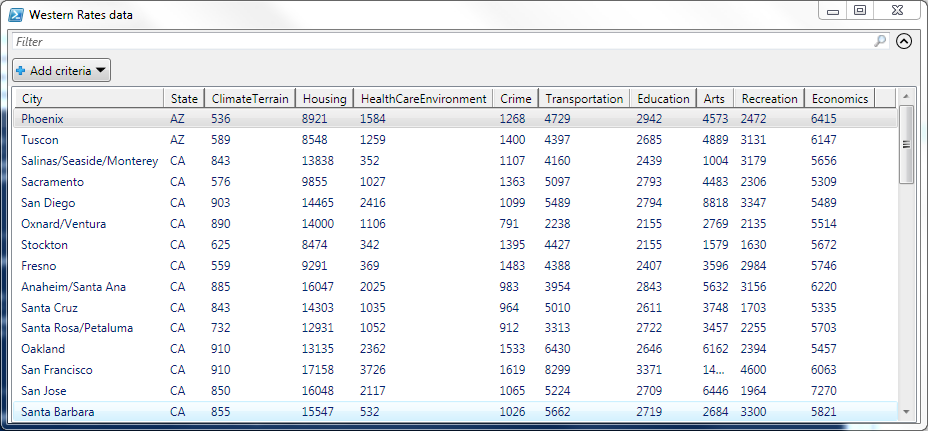
In about 30 lines of PowerShell script, we can build a SAS data set viewer that: Does not require SAS on the PC Provides very basic filtering capability Also allows for easy export to CSV All you need is the ability to run PowerShell scripts, and the SAS Local Data

[cue movie trailer voiceover guy] In a world where tabular data is too difficult to read and interpret, an unlikely hero is born. A small chart learns how to share BIG meaning. From humble beginnings as a SAS macro, SPARKY changed the world.
I'm sorry to say that there will be no "Dummies around Me" smart phone app for SAS Global Forum this year. That means that if you want to catch up with me, you'll have to do it the old-fashioned way: plan to be in the same place that I am,

In September 2010, I questioned whether you should care about native 64-bit client applications (or the lack thereof). At the time, SAS did not have a 64-bit version of SAS Enterprise Guide or SAS Add-In for Microsoft Office. A skeptical reader might assume that I was just trying to make
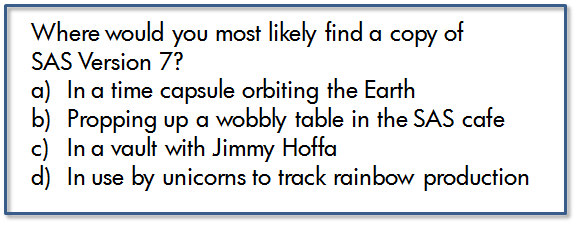
Today, SAS announces a new addition to its global certification program: you can now become "SAS Versions"-certified. Over the past 36 years, SAS has delivered hundreds of software products to the business analytics marketplace. Each of those products has a version number. As new revisions are released, the combination of
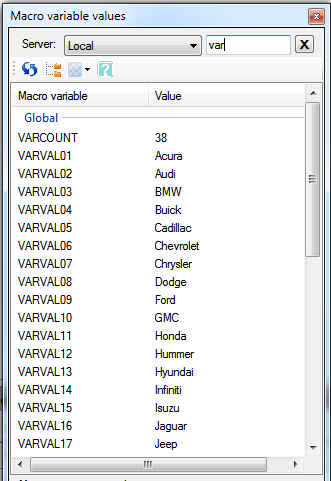
Earlier this week I described a common programming pattern in the SAS macro language. The pattern sets up a loop for processing each distinct value of a classification variable. The program uses the PROC SQL SELECT INTO feature to populate SAS macro variables. The effect: you can roll your own
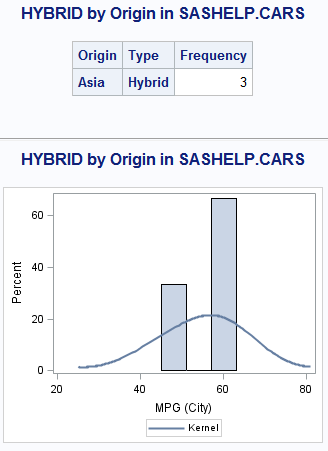
How to write a SAS macro program to repeat your SAS processing for each value of a BY grouping variable.
A well-formed WHERE statement or subsetting IF can narrow down the output of your SAS DATA step. The SAS log does a good job of telling you how many records were processed by the action. For example, let's look at this simple DATA step with my "poor man's random sample",

Did you oversleep this morning? If you live in the United States of America, Monday morning seems to have arrived just a bit earlier, accompanied by a bit more "dark" than usual. That's because as good time-fearing citizens, we have all set our clocks ahead by one hour so as
A few years ago I had the privilege of presenting the last technical paper at SAS Global Forum. This year, conference chair Andy Kuligowski asked me to go one better than that, and present a talk at the official Closing Session. What will I talk about? That's a mystery (maybe
The next time you write a DATA step, try to express it in iambic pentameter. Or instead of a SAS macro function, how about a SAS macro sonnet? (Or, for the more base among you, a limerick?) That's the spirit behind the code {poems} project. You write a poem in

